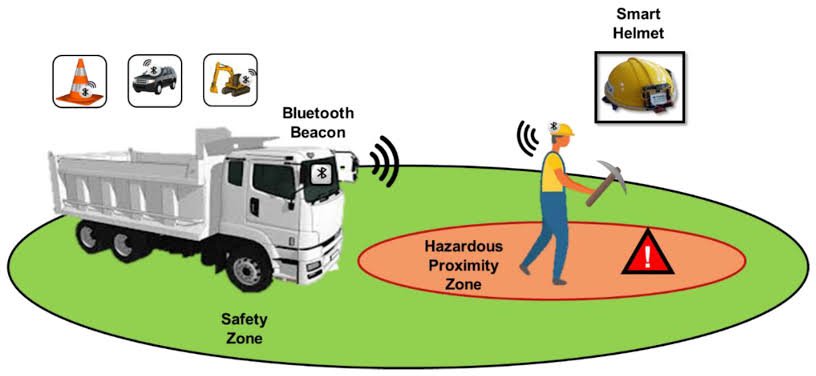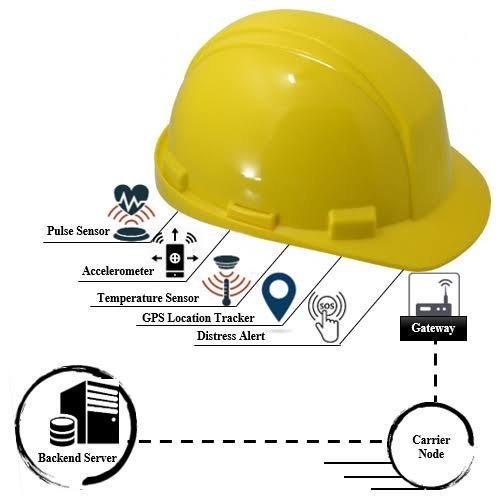
Smart helmets represent a significant advancement in personal protective equipment, integrating technology to enhance user safety across various environments, particularly in construction, cycling, and motorcycling. These innovative devices are equipped with features designed to protect users from potential harm while simultaneously providing essential information and connectivity. As workplaces and outdoor activities become increasingly dynamic, the necessity for effective safety solutions is more pressing than ever.
The construction industry, for example, is known for its hazardous conditions, with statistics indicating that over 20% of workplace fatalities originate from this sector. Moreover, cyclists and motorcyclists face high risks on the road, with studies showing that approximately 1.3 million people lose their lives each year in traffic accidents worldwide. In this context, the introduction of smart helmets becomes crucial not just for compliance with safety regulations but also for the proactive prevention of accidents.
Technological advancements have played a pivotal role in the development of smart helmets. Equipped with sensors, GPS, cameras, and heads-up displays, these helmets can monitor environmental conditions, track location, and provide real-time data to users, thus significantly mitigating risks associated with various activities. For instance, some models feature impact detection systems that send alerts to emergency services in the event of an accident, ensuring timely assistance for the user. This blend of technology and safety reflects the increasing demand for innovative solutions to tackle the challenges presented by modern environments.
As society progresses and our understanding of safety evolves, smart helmets stand out as a transformative solution that not only protects lives but also enhances the overall experience of individuals engaged in high-risk activities. Their implementation could markedly reduce the incidence of accidents and fatalities, thereby underscoring their critical importance in today’s safety-conscious world.
Overview of the ESP32 Microcontroller
The ESP32 microcontroller is a highly versatile and powerful component that plays a crucial role in various Internet of Things (IoT) projects, including the innovative smart helmet initiative. This dual-core microcontroller is not only recognized for its remarkable processing power but also for its energy efficiency, making it an excellent choice for applications that demand robust performance without compromising on battery life. With a maximum clock speed of 240 MHz, the ESP32 can handle complex computations and facilitate smooth real-time data processing.
One of the standout features of the ESP32 is its integrated Wi-Fi and Bluetooth capabilities. These wireless communication options enable seamless connectivity between the smart helmet and other devices, such as smartphones or computers. This connectivity is vital for applications requiring data exchange, such as remote monitoring and health tracking, as well as enabling users to receive notifications directly in their helmets. Furthermore, the dual-mode Bluetooth ensures compatibility with a wide range of devices, offering flexibility in how users interact with the smart helmet.
Another significant benefit of the ESP32 microcontroller is its low energy consumption. Designed with power efficiency in mind, the microcontroller incorporates various modes of operation, allowing it to enter deep sleep when not in active use. This feature not only prolongs the battery life of the smart helmet but also enhances the overall user experience by reducing the frequency of charging cycles. As a result, the ESP32 supports long-duration usage scenarios vital in safety equipment where proactive functionality is essential.
In essence, the ESP32 microcontroller combines powerful processing capabilities, comprehensive connectivity options, and energy efficiency, making it the ideal choice for developing innovative solutions in smart helmets and beyond.
Key Features and Functionalities of the Smart Helmet ESP32 Project

The Smart Helmet ESP32 Project integrates several innovative features designed to enhance user safety and convenience during various activities. One noticeable functional capability is hands-free communication. With the integration of an embedded microphone and speaker system, users can engage in voice conversations without needing to remove their helmets. This feature is particularly beneficial during construction work or cycling, allowing individuals to communicate effectively while keeping their hands free for other tasks.
Another essential functionality is fall detection. The smart helmet is equipped with accelerometers and gyroscope sensors that can detect abrupt changes in motion. When a fall is detected, the helmet can automatically send emergency alerts to predefined contacts, providing crucial assistance when needed. This is especially vital for individuals working in hazardous environments or engaging in extreme sports, where a fall could result in severe injuries.
The inclusion of GPS navigation further enhances the helmet’s functionality. Users can receive real-time directions through auditory feedback, allowing them to maintain awareness of their surroundings yet still have access to navigation information. This is particularly significant for cyclists or outdoor enthusiasts who venture into unfamiliar terrains.
Environmental sensing capabilities also play a significant role in the Smart Helmet ESP32 Project. The helmet can monitor air quality, temperature, and other environmental factors, notifying users of potentially hazardous conditions. For example, if air quality deteriorates due to pollution or dust, the helmet can alert the wearer, prompting them to take necessary safety precautions. Furthermore, a built-in temperature sensor can warn users of extreme heat or cold, safeguarding them against environmental risks.
These integrated features make the Smart Helmet ESP32 a versatile tool, enhancing safety and convenience for users across various activities, from construction to outdoor adventures.
Implementation and Future Prospects of the Smart Helmet Project
The implementation phase of the Smart Helmet ESP32 Project marks a critical juncture in the development of safety technologies. The process initiated with thorough research into the functionalities desired in the helmet, such as communication capabilities, sensors for environmental monitoring, and emergency response features. The integration of the ESP32 microcontroller was pivotal, offering both Wi-Fi and Bluetooth connectivity, which allows the helmet to seamlessly connect to devices and the Internet of Things (IoT). Early prototypes were designed, tested, and refined through continuous iterations based on user feedback and performance assessments.
Nonetheless, several challenges arose during the development of the smart helmet. One significant hurdle was ensuring the durability of the electronic components while maintaining user comfort and safety standards. To address this, the team explored various materials that would not only protect the hardware but also withstand harsh working conditions typical of industrial environments. Additionally, battery life posed another challenge, as the helmet needs to operate efficiently throughout extended periods of use. Testing solutions such as energy harvesting techniques and low-power design principles became essential in enhancing the overall usability of the helmet.
Looking towards the future, the evolution of smart helmet technology is expected to be heavily influenced by advancements in IoT and artificial intelligence. These technologies promise higher levels of integration, potentially allowing for real-time data collection and analysis, personalized alerts, and predictive safety measures. As industries increasingly prioritize occupational safety, the smart helmet has the potential to set new standards, ultimately influencing safety protocol enhancements across various sectors.
To actively participate in the evolution of this innovative technology, readers can engage in DIY projects linked to smart helmet development, join forums dedicated to tech innovations, and provide feedback on existing prototypes. Supporting research and development initiatives in this area can further propel advancements and contribute to safer workplace environments.
